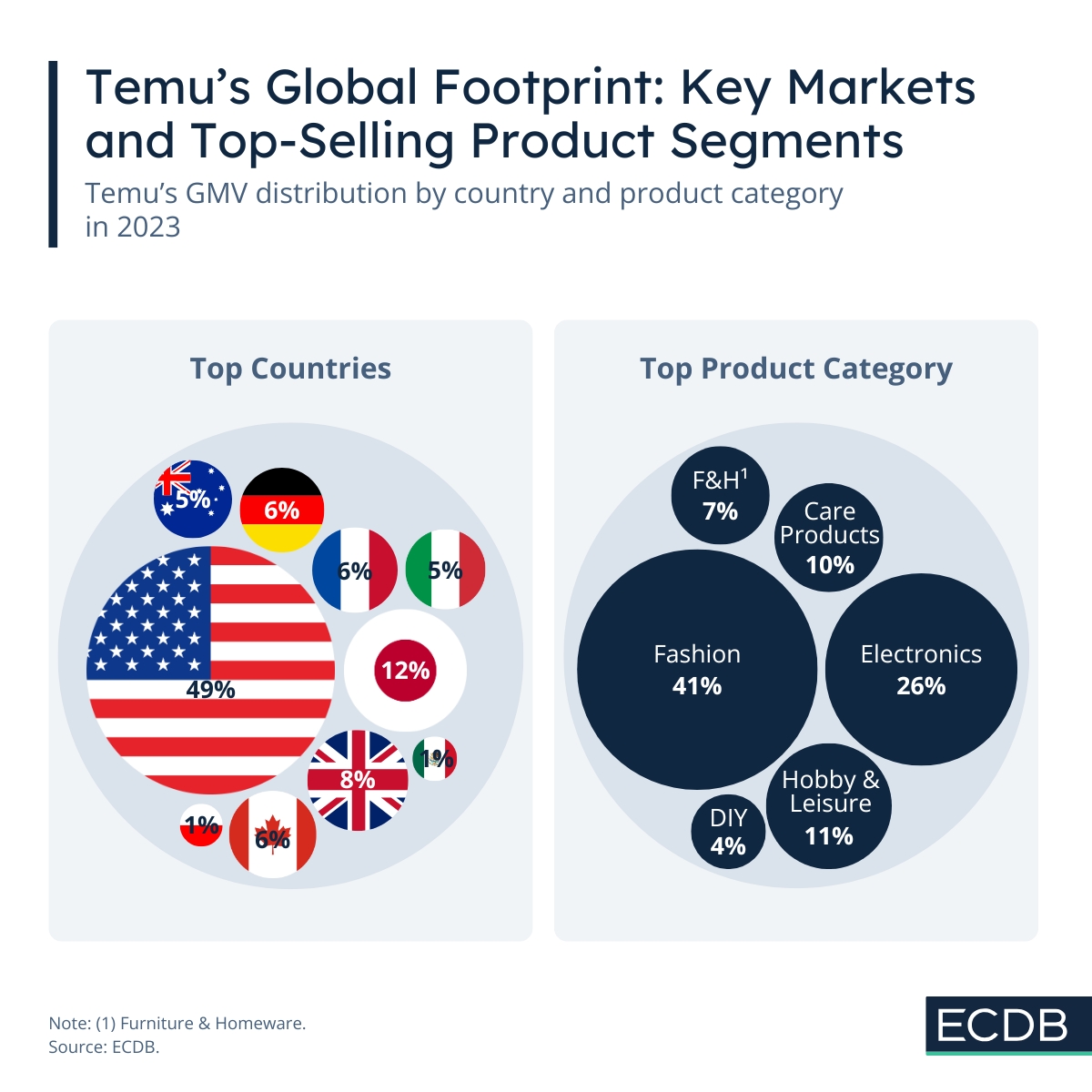Temu Ranks Third and Upward in 10 Central and Eastern European Countries
Temu is known for its low prices, wide selection, and gambling approach. Its ascent in Europe is already a hard fact. Here's what that looks like in numbers.
Business Models in eCommerce
Temu is growing at lightning speed, shaking up Western markets with rock-bottom prices. Between hype, record-breaking numbers, and increasing regulatory pressure, one question remains: is Temu here to stay?

Antonia Tönnies
Data Journalist
April 29, 2025
Retailers

Cheap, cheaper, ultra-cheap – when it comes to low-cost shopping, there are many options in eCommerce. Among them is Temu, a replica of pinduoduo.com designed for international markets outside of China. It commercializes factory-to-consumer or F2C sales.
In just two years, Temu has gained tremendous traction in Western countries. It is cheaper and younger than most retailers. Is Temu here to stay?
For Temu, it is about prices, endless products, and discounts on top. Its marketing is successful, as you probably heard about Temu on the Super Bowl, the UEFA Euro or Olympic Games. Consumers are exposed to Temu all over the internet, be it through sponsored search engine or social media posts.
Temu adapts and grows, which is why even market leaders are rolling out comparable concepts to stay on top of the wave: Something must Temu be doing right. Temu plans to stay, which is visible in its strategic moves, given collaborations with courier services such as DHL and a general shift towards the local-to-local marketplace model.
Instead of shipping from China to Europe, avoiding tariffs means moving closer to the scene. Local businesses are ready to engage in most cases, given an increase in revenue and exposure to larger audiences. Temu’s conditions on seller fees are most likely going to determine more longer-range success though.
What does Temu sell anyway? Yes, it is a little of everything, but what exactly is that?
Fashion is currently Temu’s strongest vertical, accounting for 41% of its total GMV, followed by Electronics (26%). Other categories such as Hobby & Leisure (11%), and Care Products (10%), as well as Furniture & Homeware (7%) & DIY (4%) are smaller, but play a supporting role.
The future of Temu’s product mix is likely to evolve, given the current restructuring of its logistical route and seller affiliation. That makes it easier to send bulkier packages and enhance Temu’s appeal. Retailers like Wayfair already feel the effect of Temu’s success in selling what everyone sells – but cheaper.
It’s a curious case with Temu, all of a sudden it was everywhere. Within just two years of operation, it is now available in more than 30 markets.
Of those, the United States is Temu's top market. 49% of Temu’s GMV is generated in the U.S. Other leading regions are Japan (12%), the UK (8%), Germany (6%), France (6%), Italy (5%) and Australia (5%).
Temu serves customers all over the globe, except for Africa. Latin America and Australia belong to its markets of operation, just as destinations in Europe or North America do.
The impending tariffs are – by intention – a direct blow to businesses like Temu. A tax of several times the original product price is designed to turn the D2C business model unprofitable real quick. But this is for products from China; Temu will use logistics and manufacturing facilities in the country of operation to remain in business.
Temu is aiming at becoming the go-to marketplace for products of all kinds, with an added self-discovery journey that consists of games, discounts, and social elements.
So is Temu here to stay? For now, yes. Temu's growth isn't just hype – it's backed by numbers, a smart business model and perfect timing. It came at a time when consumers were struggling with rising costs due to economic challenges and instability. Temu has long been touted as the next Wish, but all signs point to Temu becoming a force to be reckoned with.
What sets Temu apart is not just its timing, but its ability to adapt: whether it's logistics partnerships like the one with DHL, or first steps toward compliance with international regulations. This suggests that Temu isn't just looking for short-term gains, but is building a model with long-term potential. That could turn Temu from a discount sensation into a mainstay of Western eCommerce.
Related Articles
Temu is known for its low prices, wide selection, and gambling approach. Its ascent in Europe is already a hard fact. Here's what that looks like in numbers.
What do wish.com, riteaid.com, and gamestop.com have in common? They are all featured in the bottom list of monthly retailer growth in a year-on-year depiction. Here's why.
Online grocery is a dynamic and competitive market, with high growth potential given the right strategy. In Germany, onyl few retailers drive a successful business in the sector. They include rewe.de and flaschenpost.de. Others are lagging or high and thriving.

Click here for
more relevant insights from
our partner Mastercard.
Our Tool
We’re not just another blog—we’re an advanced eCommerce data analytics tool. The insights you find here are powered by real data from our platform, providing you with a fact-based perspective on market trends, store performance, industry developments, and more.
Analyze retailers in depth with our extensive Retailer dashboards and compare up to four retailers of your choice.
Learn More
Combine countries and categories of your choice and analyze markets in depth with our advanced market dashboards.
Learn More
Compile detailed rankings by category and country and fine-tune them with our advanced filter options.
Learn More
Discover relevant leads and contacts in your chosen markets, build lists, and download them effortlessly with a single click.
Learn More
Benchmark transactional and conversion funnel KPIs against market standards and gain insight into the key metrics of your relevant market.
Learn More
Our reports provide pre-analysed data and highlight key insights to help you quickly identify key trends.
Learn More
Find your perfect solution and let ECDB empower your eCommerce success.